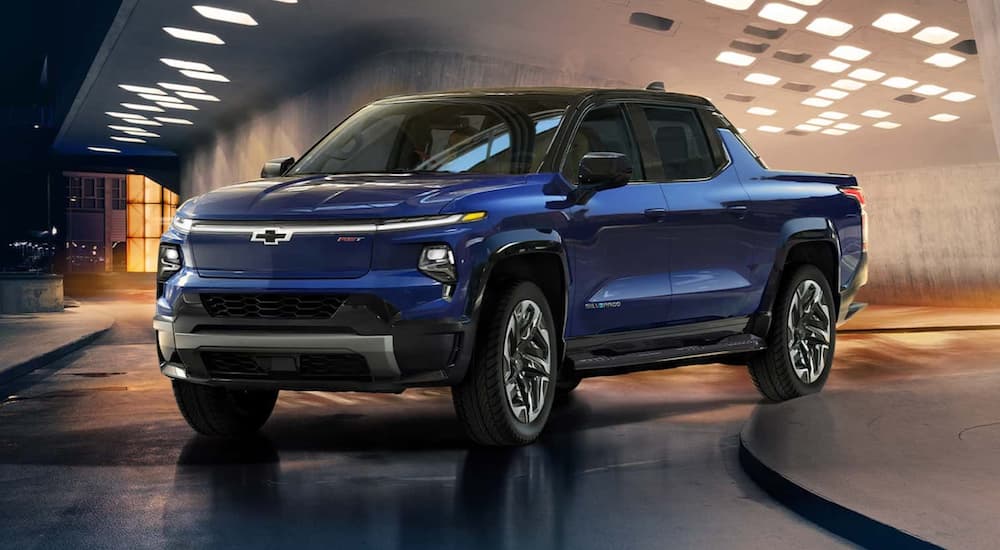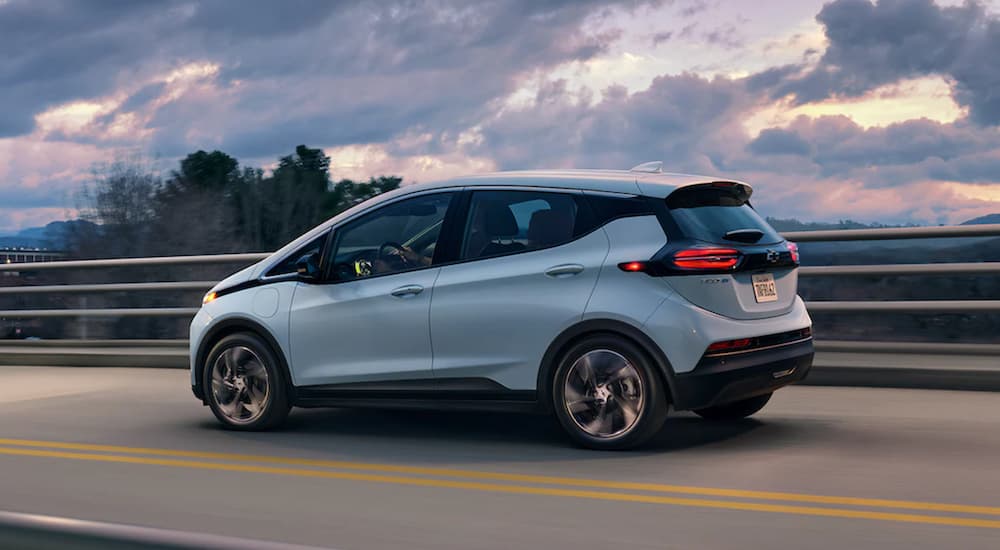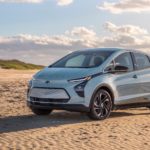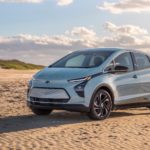Chevy’s renewed commitment to its EV lineup couldn’t come soon enough for longtime fans of the brand. Case in point: when an all-electric version of Chevy’s flagship truck went live on the company’s website earlier this year, reservations for the Silverado EV First Edition were snapped up in just 12 minutes. As the segment grows, Chevy’s EV plans grow along with it. There’s little doubt that there’s an appetite for the brand’s EV offerings at Chevy dealers across the nation. In fact, last year Chevy moved more units of its affordable Bolt EV and EUV than it has in any year since the vehicle was introduced in 2016. While the Bolt could be on its way out (more on that later), the brand is likely encouraged by that sort of robust interest in a vehicle that’s been on the market for almost seven years and is doubling down on its electric lineup.
At the recent Consumer Electronics Show (CES), Barra made this commitment clear with the announcement that GM plans on delivering 400,000 EVs by the end of 2023. This includes a number of electrified Chevy models as part of a push that will see GM introduce 20 new EV models by 2025. “We’re super excited about the response that we’re getting,” said General Motors CEO Mary Barra. “As our most popular vehicle brand, Chevy will be front and center in our mission to provide EVs for everyone,” Barra said. “We’re at the tipping point of electrification, and we are expecting this to be a massive year for Chevrolet’s EV future.”
It’s an ambitious plan to be sure. EVs currently account for around 10 percent of new vehicle sales in the U.S., but the segment has been rapidly growing in recent years. Perhaps the most encouraging sign of an impending all-electric future is the steady rollout of EV pickups. A number of top brands have introduced or announced electric versions of their best-selling trucks in recent years, and steady sales and pre-orders could well signal a change in the sector. The excitement around EV pickups is particularly encouraging, proving that even some of the most old-school gearheads are intrigued by new electric offerings.
This is in part due to a growing acceptance of EVs of all kinds, but perhaps more importantly, brands are now getting the chance to prove that going electric doesn’t entail the sort of sacrifices it once did. The torque and subsequent acceleration advantages of the EV design are a big selling point, often resulting in a vehicle that’s actually more powerful than its gas-powered counterpart. The theory is sound, but being able to demonstrate it is another thing and as more EV trucks and sports cars hit the market, it’s getting harder than ever to deny their considerable advantages. In other words: once the Ford Mustang goes electric, you know the future is here. Let’s take a closer look at some of the all-electric models that will move Chevy into this future, along with the new Ultium EV platform that’s making it all possible.
Silverado
It makes sense that Chevy’s most popular vehicle would lead the brand’s electric effort. Far and away, Chevy’s best-selling model, the Silverado, has already garnered strong interest with the rapid sellout mentioned above. Chevy will follow up the First Edition with a Silverado Work Truck (WT) in 2023, and a feature-packed luxury model dubbed the Silverado RST in 2024. The First Edition retails for more than $100,000, but Chevy has indicated that it will eventually roll out models priced between $50,000 and $80,000.
While the price tag might seem high, the Silverado EV is arguably the most capable pickup Chevy has ever produced. A lot of this comes from some of the peculiarities of the EV setup, which allows the Silverado to offer four-wheel steering, dual-motor 4WD, and an onboard power supply which can provide up to 10.2 kW of juice to power a variety of tools and tech. Chevy says the Silverado will have a range of around 400 miles, with the WT trim offering 510 horsepower and 615 pound-feet of torque (664 horsepower and 780 pound-feet of torque on the RST model). The pickup will have a maximum towing capacity of 10,000, which rockets up to an impressive 20,000 on an upcoming fleet model. Fast-charging capability will also allow the Silverado to regain 100 miles of range in as little as 10 minutes: an important factor that ensures drivers will never have to spend too much time waiting around for their truck to “refuel.”
With 400,000 EVs to produce by 2023, Chevy isn’t messing around in bringing the Silverado to market. The company is investing $7 billion across Michigan to ramp up vehicle and battery production, converting its Orion plant, currently producing Bolts, over to Silverado EVs, as well as announcing plans for an entirely new truck-specific facility to complement the existing Factory Zero location. The Orion facility will churn out both the Silverado as well as its GM pickup stablemate, the GMC Sierra.
Bolt EV and EUV
While the model has remained popular with drivers, it could be curtains for the Chevy Bolt. Strong sales figures helped buoy the subcompact even through some recall issues, but as Chevy looks towards the future, it’s hard to see a place for the Bolt. This is largely informed by the fact that the Orion plant where the Bolt is assembled will soon be retrofitted to become Chevy’s second EV pickup factory thanks to a $1.3 billion investment from GM.
This doesn’t mean the Bolt was a failure by any means. The reasonably priced subcompact succeeded in winning over EV-skeptics, following up on the success of Chevy hybrid electric Volt and introducing the EV concept to a whole new set of drivers. Chevy was so invested in turning consumers on to the advantages of electric vehicles that it reportedly lost as much as $9,000 on every Bolt sale, proving just how committed the brand was to whet the public’s appetite for EVs.
Blazer
The Blazer, a mid-size crossover revived in 2019 and named after the model that virtually launched the whole SUV craze back in the ’90s, has the chance to similarly define the EV generation of SUVs. Details are scant for the time being, but Barra confirmed the Blazer will debut in 2023 as a 2024 model. The model will likely be larger and more expensive than the Equinox, but if Barra’s comments are any indication, there should be plenty of room for customization. Expect the Blazer to slot above the Equinox in both size and price, as the current gas-powered version currently retails for around $35,000.
Equinox
As Chevy’s second-best-selling model and an ever-popular crossover SUV to boot, an EV Equinox was never in question. The LS version of the EV Equinox is expected to debut in Fall 2023 in both fleet and retail versions, with an RS model to follow in the near future. With an expected starting price of around $30,000, the Equinox is poised to become an instant competitor within the sector. Details on battery capacity and range are still up in the air, but some early looks at the model showcase an impressive redesign to both the interior and exterior. “Sleek” is the watchword here, with aggressive, almost futuristic exterior styling and an interior cabin replete with multiple large display screens.
Sub-$30,000 Ultium-Based EV
Not much in the way of details here, but as part of GM’s quarterly earnings call, Barra made mention of an ultra-affordable Ultium-based EV that will slot in just below the Equinox. “Affordable EVs are part of the market that start-ups aren’t targeting, but they are key to driving mass adoption of EVs, which is a national and a global priority. That’s why we plan to follow the Equinox with an even more affordable EV,” said Barra. This yet-to-be-announced EV will likely replace the Bolt in Chevy’s lineup, offering drivers an affordable entrée into the EV sector.
Ultium
GM’s push for a lineup of affordable EVs is made possible thanks to its homegrown Ultium electric architecture. In designing a platform that can be shared across varying models, Chevy is able to drastically reduce the cost associated with research and development. The Ultium platform – designed in collaboration with GM and LG Chem – is able to support 19 different battery and drive unit configurations, making it an ultra-flexible solution that will go a long way in making the brand’s EVs more accessible.
An Encouraging Future Ahead
Chevy’s ambitious goal of delivering 400,000 EVs by 2023, along with the massive investment in EV-specific plants, are both encouraging signs for the growth of the sector. Having proved its EV cred over the years with the Bolt, we’re encouraged that this forthcoming all-electric lineup will continue to build on Chevy’s considerable success in the sector. The Silverado EV represents the first step in this campaign, and if early results are any indication, there are going to be some fun surprises along the way. Drivers are sure to be intrigued by some of the advanced tech and features made possible by the EV setup, like the Silverado’s Wide Open Watts mode, which allows the pickup to post a blazing 4.5 zero-to-60 time, or its four-wheel steering, which drastically improves maneuverability at low speeds. The brand’s commitment to affordability has played a huge role in normalizing EVs over the last decade, and it looks to be no different moving forward. The yet-to-be-announced sub-$30,000 model has the potential to be a game-changer within the EV sector, opening up an electric future to a much wider slate of drivers.






